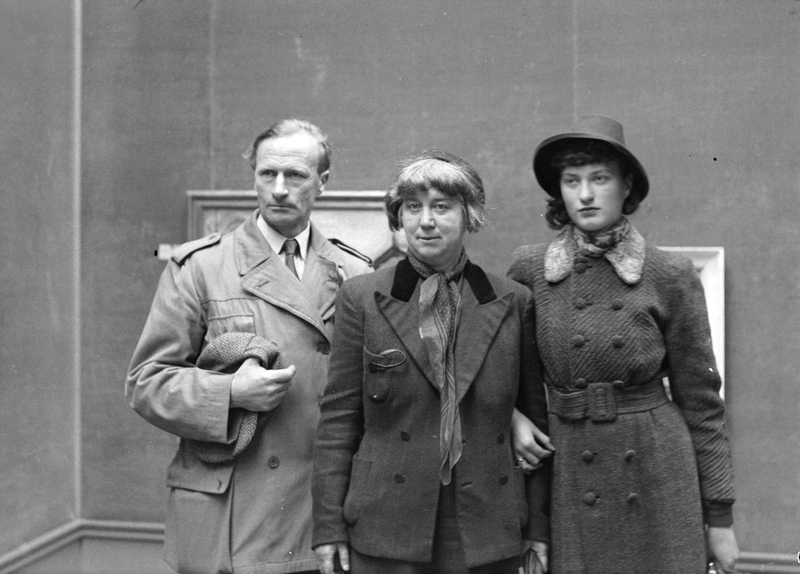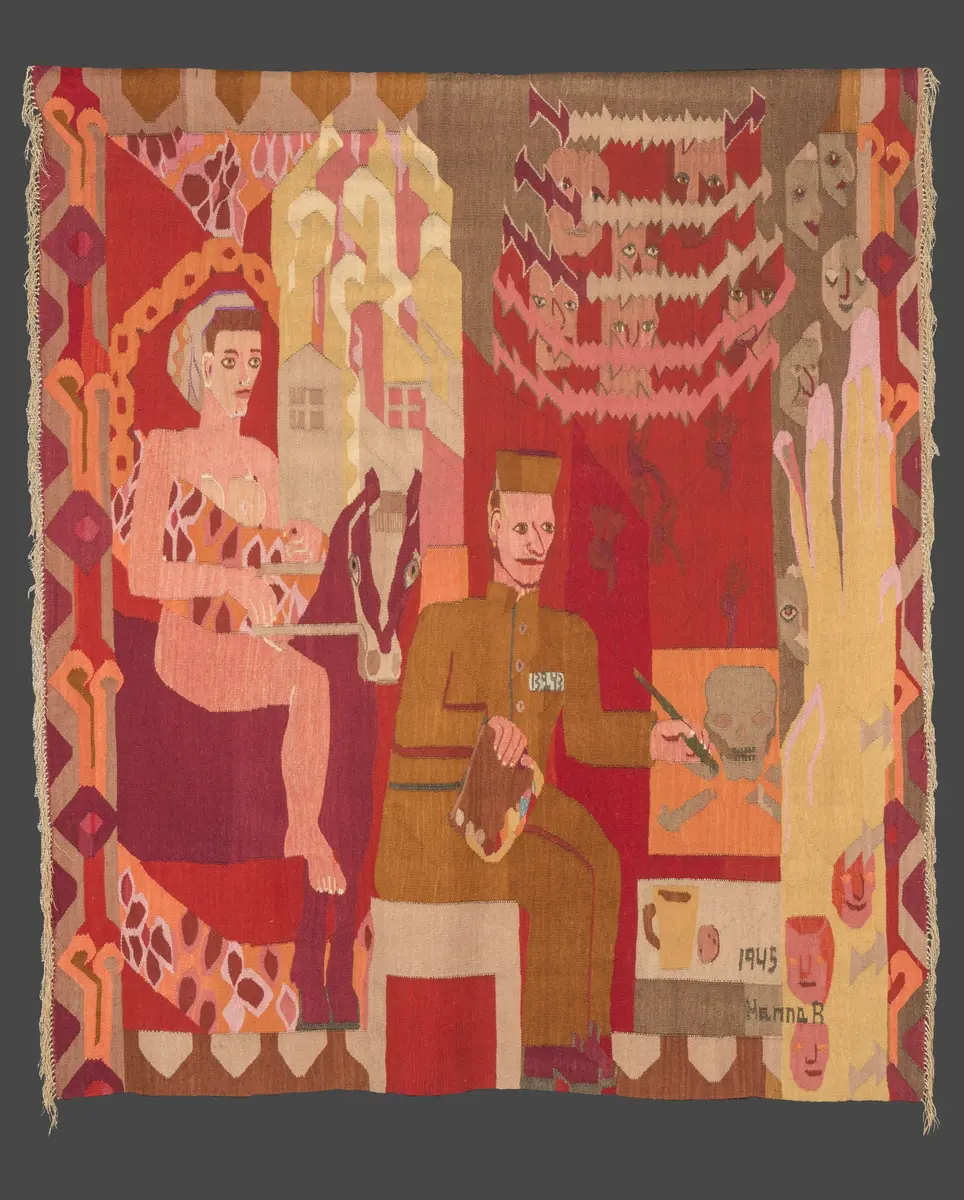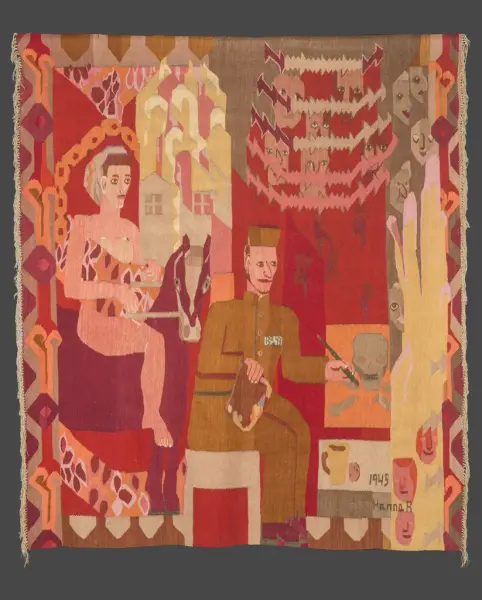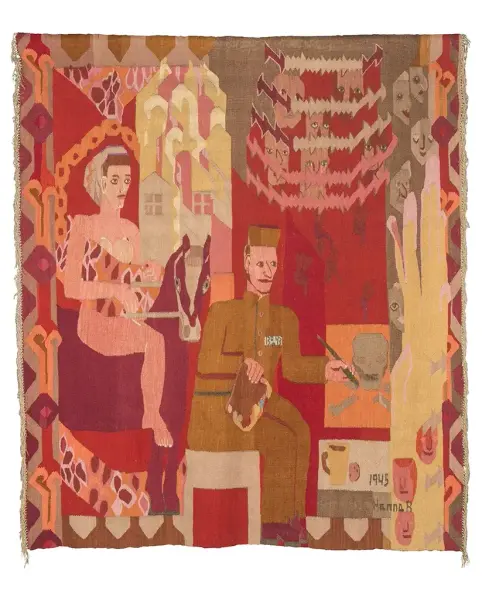Hannah Ryggen
Grini, 1945
tapestry
191 x 167 cm
From the collection of Trondheim Kunstmuseum
The subject matter of Hannah Ryggen’s tapestries is broad, based both on her experiences in life and her political convictions. Struggles against war, fascism and social injustice, most of it in solidarity with similar causes across the world, characterized Ryggen’s works.
When the war came to Norway in 1940, the municipality where she lived, Ørland, was heavily affected: there was a military airfield there, a large German troop presence and several prison camps with Russian and Serbian prisoners of war. Ryggen was impacted personally when her husband, the painter Hans Ryggen, was captured by the Nazis for suspected resistance activities and sent to the Falstad prison camp. Later, he was transferred to Grini and, towards the end of the war, he was taken to Mysen. This forms the theme of the tapestry Grini which depicts her husband, with prisoner number 13243, as he paints a skull and crossbones, while their daughter Mona, naked on a horse, brings a piece of their home island of Fosen to him.
Before the war, the couple worked at a farm in Ørland making art together, living a simple life with little money and close to nature. Ryggen worked using a loom that Hans built for her, weaving with yarn that she carded, spun and dyed herself, as well as with linen that she had grown and processed. In Grini she seems to be willing Hans to hang on, so that they can once more be together. Through the messenger, their daughter Mona, Hannah bestows a dream on her husband, showing him a way out of captivity.
Ryggen shows how craft and fine art can exist in the same sphere. While often her works express modernist compositional sensibilities, in this work she seems more anchored in folk art motifs with their literal symbolism. According to Marit Paasche, “The fiery red hues symbolize both intensity and danger. The nude woman on horseback sent with flowers to liberate the captive is like an image from a fairy tale...”[1]
Hannah Ryggen donated the tapestry to Trondhjems Kunstforening in 1965.
- Marianne Zamecznik
[1] Marit Paasche, Hannah Ryggen: Threads of Defiance, Thames & Hudson, 2019
 Image from digitaltmuseum.org
Image from digitaltmuseum.org Hans, Hannah and their daughter Mona Ryggen at Tronhjem Kunstforening, 1945. Foto:Schrøder/Sverresborg Trøndelag Folk Museum
Hannah Ryggen, born Hannah Josefina Maria Jönsson (she/her, b.1894, Malmö – 1970, Trondheim), was a textile artist. Originally trained as a primary school teacher, she taught during the day and took evening classes in drawing and painting at the technical college in Lund. On a study trip to Dresden, she met her future husband, the artist Hans Ryggen. The young couple moved to Norway, to Ørlandet in Trøndelag County. In 1923 she discovered weaving’s potential to express what she could not in painting. She became fascinated with its affinity with vernacular art and saw political potential in this traditional medium. She became the first textile artist to participate in the Norwegian annual Autumn Exhibition at Kunstnernes Hus in Oslo (1964), and the first female artist to represent Norway at the Venice Biennale (1964). Continuing to work until the end, Ryggen died in 1970 at the age of 75.
Production credits
Hannah Ryggen, Grini, tapestry, 191x167 cm, 1945
From the collection of the Trondheim Kunstmuseum


